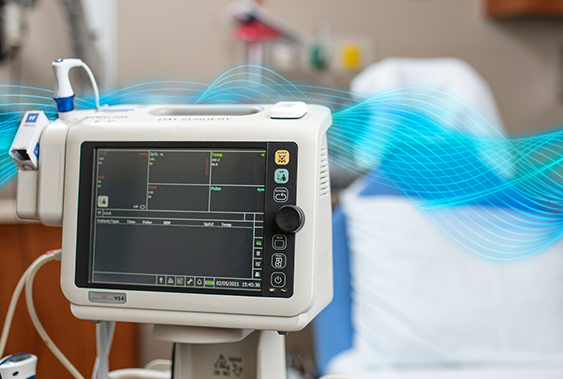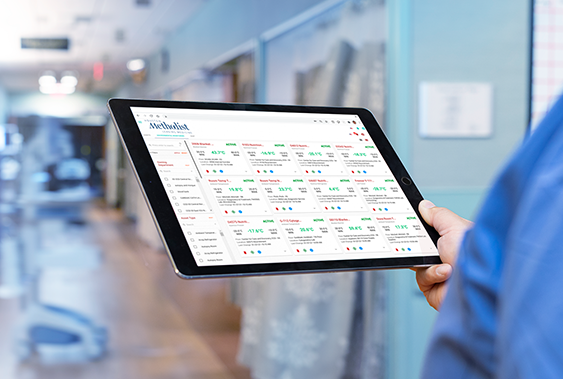Asset Tracking and People Monitoring to Improve Health Care
[Note: This article was written by Brad Shaink, administrative director of innovation and IT business applications, and was originally published earlier this year in Roberta Schwartz’s DIOP Newsletter on LinkedIn.]
Most of us have become accustomed to tracking services on our mobile phones to help us know where our family and friends are at any given time. Tags to track our belongings, such as AirTags, have reached a lot of popularity recently as well. The health care industry is no different in that workers spend too much time looking for equipment to take care of patients, so as a result, hospitals must over purchase the number of pieces of equipment they actually need to ensure availability for patient care. This issue, coupled with lost and stolen equipment, leads to unnecessary and burdensome costs for hospitals.
At Houston Methodist, we focused on finding the best solution to monitor our people and track our assets in order to create efficiencies and improvements in patient care. This industry technology is referred to as Real Time Location Services and our platform partner, Intelligent Locations, enables us to combine innovative tracking technology with advanced Artificial Intelligence algorithms.
Results include:
- A comprehensive HIPAA-compliant solution to drive measurable improvements in clinical outcomes
- Patient monitoring, equipment location services, environmental system monitoring, and more across the hospital system
- Improved patient experience, staff safety, and hospital-wide financial results
How It Works
The solution appears quite simple but relies on state-of-the-art technology throughout our hospital system to ensure timeliness and accuracy. A beacon is placed on what is being tracked, and thousands of gateways are placed around the hospital buildings (about every 30 feet) to listen for the beacon to pass by and update location information. Software as a Service (SaaS) brings together the beacons and gateways to make it all work.
Employees are able to use a central dashboard to monitor asset location and status, a mobile app for those on-the-go, and integration into our electric medical record (EMR) software to create further efficiencies by working in one single platform.

Tracking Assets
Finding equipment more easily with room level accuracy is critical. We apply more than 50,000 tags to our assets and then monitor their availability and idle status. With near real-time updates and accuracy within 12 inches, we can find assets more quickly and reduce the quantity of some assets we are purchasing.
Assets we track include:
- MyMethodist Patient Engagement Tablets in each patient room
- Biomedical Equipment
- Wheelchairs
- High Value assets that may be lost easily such as telemetry devices
- Surgical trays through the autoclave process to streamline Sterile Processing Department (SPD) processing
Monitoring People
Improving patient flow, reducing patient wait times, and expediting patient discharge status are all critical. By using temporary tracking beacons affixed to patients, we can monitor patient movement to monitor and improve workflows to ensure optimal patient care and experience. Improving clinical efficiencies can be gained by coupling real-time tracking data of clinical staff with AI powered analytics to drive improved performance and decrease operational expense.

Environmental Monitoring
Monitoring a range of environmental conditions to ensure Joint Commission standards is crucial. We monitor thousands of freezers and refrigerators to track conditions, safeguard materials, reporting and compliance, and alert hospital personnel when intervention is required.
AI can support Houston Methodist advancing RTLS in several ways:
- Improved Data Analysis: AI can analyze large amounts of data generated by RTLS sensors and provide insights into patterns and trends that are not easily discernible through traditional methods. This can help improve decision-making and operational efficiency.
- Predictive Analytics: AI can use data from RTLS sensors to predict events, such as equipment failures, congestion, or bottlenecks, before they occur. This can help prevent downtime and increase productivity.
- Machine Learning: AI can use machine learning algorithms to optimize RTLS systems over time. By analyzing data from sensors and feedback from users, the AI can learn which approaches work best and identify areas for process improvement that could yield to better operational outcomes.
- Automation: AI can automate routine tasks, such as monitoring and alerting, allowing operators to focus on more complex tasks. This can help reduce errors and improve response times.
- Personalization: AI can use data from RTLS sensors to personalize experiences for users, such as providing customized directions or recommendations based on their location.
All of this technology will be built on top of a flexible and powerful infrastructure system that has been carefully planned and will support our Smart Rooms in the Hospital of the Future. You can read more about the Houston Methodist Center for Innovation RTLS pilot in our Case Study.

